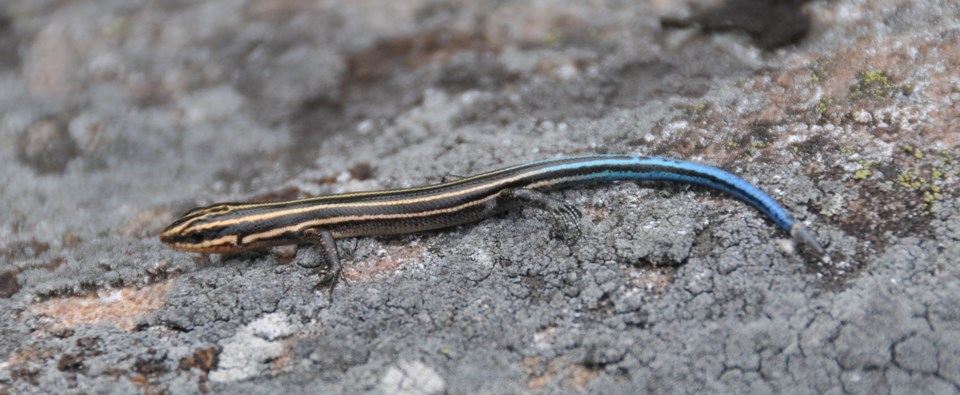Skinks suffer from onomatopoeia, as do sloths. You will no doubt recall from English class that onomatopoeia is when a word sounds like its meaning (or maybe you skipped that class… was it worth it? Bet you're sorry now.)
Skinks, which are actually rather shy lizards, sounds like they were named from a combination of skulk and slink. If so, then onomatopoeia works in this case.
However, what I'm not sure of is the plural form of skink: some documents refer to them as skink, like sheep and deer in their plural forms; yet other writings call them skinks, but certainly not skinkses just as sheepses and deerses do not exist. But I digress.
Skink(s) are the only species of lizard found living in Ontario. There are about 1,200 species of skink(s) out there, but only this one can be found around here. And even then it's hit or miss as to whether you'd find even one when looking for them.
Not only are they shy, but their population is low in number and scattered in locations.
Literature states that skinks can grow to be about 20 centimetres in length (or 7.874 inches) but the ones I've seen I'd guess are around 5.094 inches, or smaller.
Young skinks have bright blue tails, while the adults are less punkish looking with just dark grey stripes on a light grey background. Being lizards, they have scales and claws, unlike salamanders which are smooth and soft-toed (come to think of it, salamander sounds a bit onomatopoetic too).
To find a skink, you have to go to the Land In Between. This is not a movie set for zombies or a new reality TV series, but rather is the area of land where southern Ontario hardwoods brush up against northern Ontario conifers. Some people call it cottage country.
Hiding under small broken boulders of granite, these lizards thrive on a diet of ants, woodland cockroaches, crickets and small worms. Being predators they are fast on their feet; and also being prey to raccoons, foxes, big songbirds and such, they are fast on their feet. In a word, skinks are fast.
To photograph a skink, you, too, have to be fast. Your camera has to be fast focusing. The film speed has to be fast. The shutter speed has to be fast. Your reflexes have to be fast. Photographing skinks is not recommended for the faint of heart. Yes sir, this quest is all about high-speed skills.
I have some earlier photos of rock surfaces, complete with a grey blur and a touch of a blue smudge. These are pictures of skink taken before I became fast. I keep them to remind me that skinks are a challenge to photograph, and good challenges come by far too infrequently.
A while back a team of us were exploring an area that is smack dab in the middle of skink country. We had our lunch break sitting atop a bare patch of the Canadian shield, musing the possibility of finding any of the rare species that inhabit the locale.
On the list of possible discoveries were massasauga rattlesnake, spotted turtle, Virginia meadow beauty, yellow-eyed grass and five-lined skink. So far we had found none of the above.
Immediately after lunch comes that back-to-nature feeling when your body tells you that somethings gotta go. Being the gentlemen we are, Mark and I waited while Kristen wandered off down the trail for a while. She took a long time. We called. She answered that she was flipping rocks, looking for skinks. I wandered off, a bit quickly, in the other direction.
After communing with nature beside a rather large pine tree, I, too, decided to seek out a skink or two. A large flat rock atop a small rounded ridge looked promising, so I gently raised it up for a peek underneath.
BINGO! A young skink with a bright blue tail flashed out into the open, circled, and on the return loop found sanctuary under my boot.
On the hard rock, the small space in front of my boot heel provided excellent skink habitat. Hmm. I dare not move or I may harm the little guy. And I didn't have my camera in hand because I was, you know, recently doing other things.
A call to the others brought them running, along with my camera. An explanation of the situation was given, and Kristen dropped to the ground and peered under my boot. Yep, still there.
I set the camera for fast shutter. I then set the camera on motor drive. I then set the focus on automatic. I focused on the surface of the rock beside my boot. A deep breath and I quickly lifted my boot aside and pressed the shutter! BAM-BAM-BAM-BAM! Four photos of the skink!
It stayed there, blinking in the sun. BAM-BAM-BAM! Three more pics of a skink sitting on a rock! (Gosh, but motor drives were noisy in those days.)
It continued to stay there. Didn't move at all. Quite unskink-like. As I knelt down I kept the shutter button pressed halfway, ready for that moment when the skink would blast forward to the cover of a nearby rock.
The camera came ever closer, the skink moved its head to look at me, and BAM-BAM-BAM-BAM-BAM-BAM as I accidentally hit the shutter when I lost my balance.
As I fiddled with the camera trying to undo settings like motor drive and autofocus, the skink wandered away. Quickly, mind you, but in a rather nonchalant manner for a skink. Ah well, it escaped in good health and I had (several) good pics of Ontario's only lizard species.
Did you know that camera gadgetry is onomatopoeia; at least I'm pretty sure it is.
